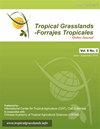在尼日利亚高原州乔斯凉爽的热带气候中,四种豆科植物的产量和营养成分受生长年龄的影响
IF 0.9
4区 农林科学
Q3 AGRICULTURE, DAIRY & ANIMAL SCIENCE
引用次数: 0
摘要
在尼日利亚Jos的热带高纬度环境中,以2种温带(Trifolium pratense和T. repens)和2种热带(Stylosanthes guianensis和centroma molle syn. C. pubescens)饲草豆科植物为试验材料,研究了生长年龄对建立年份饲料产量和养分浓度的影响。试验分为4个收获期(播种后9、13、17、21周);WAS) × 4种豆科植物(2种温带和2种热带)的因子处理安排采用随机完全区组设计,共4个重复,分别于2015年和2016年生长季节进行。2015年,贵阳螺产量最高(p.t repens)。molle是的>。(P<0.05),而草料中磷含量随收获年龄的增长而下降,只有热带豆科植物差异显著(P<0.05)。洗涤纤维(NDF)和ADF (ADF)浓度在各采收期均较高(P<0.05)。非线性回归分析表明,6月上旬在该环境下种植的饲用豆科植物,分别在15、16、18和21 WAS的最佳收获期为pratense、T. repens、S. guianensis和C. molle。但是,需要对温带豆科植物进行更多的研究,特别是对更早的种植日期进行研究,以确定它们在这种环境下的全部产量潜力,特别是在更广泛的季节条件下。本文章由计算机程序翻译,如有差异,请以英文原文为准。
Establishment yield and nutrient composition of four legumes as influenced by age of growth in a cool tropical climate at Jos, Plateau State, Nigeria
An experiment was conducted with 2 temperate (Trifolium pratense and T. repens) and 2 tropical (Stylosanthes guianensis and Centrosema molle syn. C. pubescens) forage legumes in an elevated tropical environment of Jos, Nigeria to determine the influence of age of growth on forage yield and nutrient concentrations in the establishment year. The experiment was a 4 harvest times (9, 13, 17 and 21 weeks after sowing; WAS) × 4 legume species (2 temperate and 2 tropical) factorial treatment arrangement in a randomized complete block design with 4 replications, conducted in the growing seasons of 2015 and again 2016. In 2015, S. guianensis produced highest (P<0.05) dry matter yield (8.2 t DM/ha), while T. pratense produced the highest yield (3.6 t DM/ha) in 2016. In both years leaf:stem ratio decreased significantly with age. In 2016 crude protein (CP) concentration declined in all species as age at harvest increased (P<0.05), while at any given age highest CP concentration occurred in T. repens and lowest in S. guianensis (P<0.05). At any age, concentration of calcium followed the pattern T. pratense>T. repens>C. molle>S. guianensis (P<0.05), while phosphorus concentration in forage declined with age at harvest with significant (P<0.05) differences only for tropical legumes. The detergent fiber concentrations (NDF and ADF) were higher in S. guianensis (P<0.05) at any harvest stage. Non-linear regression analysis suggested that these forage legumes, when planted in early June in this environment, could be harvested at the optimum stages of 15, 16, 18 and 21 WAS for T. pratense, T. repens, S. guianensis and C. molle, respectively. However, more studies, especially with earlier planting dates, need to be conducted on the temperate legumes to determine their full yield potential in this environment, especially over a wider range of seasonal conditions.
求助全文
通过发布文献求助,成功后即可免费获取论文全文。
去求助
来源期刊

Tropical Grasslands-Forrajes Tropicales
Agricultural and Biological Sciences-Agronomy and Crop Science
CiteScore
1.60
自引率
0.00%
发文量
36
审稿时长
16 weeks
期刊介绍:
The Journal publishes, in English or Spanish, Research Papers and Short Communications on research and development, as well as contributions from practitioners (Farmer Contributions) and Review Articles, related to pastures and forages in the tropics and subtropics. There is no regional focus; the information published should be of interest to a wide readership, encomprising researchers, academics, students, technicians, development workers and farmers.
In general, the focus of the Journal is more on sown (''improved'') pastures and forages than on rangeland-specific aspects of natural grasslands, but exceptions are possible (e.g. when a submission is relevant for a particularly broad readership in the pasture and forage science community).
The Journal will also consider the occasional publication of associated, but closely related, research in the form of an additional scientific communication platform [e.g. a re-make of the former Genetic Resources Communication series of the former Division of Tropical Crops and Pastures of the Commonwealth Scientific and Industrial Research Organisation (CSIRO), Australia].
Areas of particular interest to the Journal are:
Forage Genetic Resources and Livestock Production[...]
Environmental Functions of Forages[...]
Socio-economic Aspects[...]
Topics within the aforementioned areas may include: Diversity evaluation; Agronomy; Establishment (including fertilization); Management and utilization; Animal production; Nutritive value; Biotic stresses (pests and diseases, weeds); Abiotic stresses (soil fertility, water, temperature); Genetics and breeding; Biogeography and germplasm collections; Seed production; Ecology; Physiology; Rhizobiology (including BNF, BNI, mycorrhizae); Forage conservation; Economics; Multilocational experimentation; Modelling.
 求助内容:
求助内容: 应助结果提醒方式:
应助结果提醒方式:


